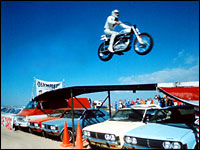On Earth Day, Wallace J. Nichols gave a keynote address at Duke University in honor of Evel Knievel entitled “Jump the Chasm: Are you an EcoDaredevil?” After the address, Elliott Hazen, a Duke University PhD student, was honored with the first EcoDaredevil award.
—–

Growing up in the 1970s, I idolized Evel Knievel. To me, he was a rock star, sports hero, and folk legend in one. He was both a daredevil and a cool character. Back then, his jumps over buses, fountains, and canyons inspired me to launch my bicycle into the air and over puddles, mounds of dirt, and many a hapless friend. Occasionally, in honor of his ill-fated jump over the Snake River Canyon, I’d jump my bicycle into the neighbor’s pond.
Now, I find new inspiration in my childhood hero.
In 1961, before “Evel” became a household name, Robert Craig Knievel hitchhiked with the rack of a bull elk from Montana to our nation’s capital to protest the culling of elk in Yellowstone. The Kennedy administration responded and countless elk were saved.
Half a century later, we face ever more serious environmental crises — loss of biodiversity, a warming planet, collapsing fisheries, looming food and water shortages for billions of people, and the realization that our pollution has reached nearly every corner of the globe. Scientists forecast a “2050 Scenario” in which Earth is hotter, dirtier, and overcrowded with 9 billion people who are left to wage wars for what little remains.
In the ocean, the once-rich ecosystems that spared us from environmental harm are failing. Right now, Ocean Conservancy is racing to return the ocean to health through sustainable fishing, protecting marine wildlife, shaping how we manage our waters, and preserving magnificent ocean places — our “Undersea Yellowstones,” as we like to call them — but serious concerns remain, chief among them climate change.
Jumping this chasm is the greatest challenge humans have ever faced. Waiting is foolish at best and disastrous at worst. Solving these problems will require revolutionary changes in society and technology, not incremental steps. We must be brave, creative, and outspoken enough to challenge the status quo in our respective industries, departments, and neighborhoods. We must undertake the audacious, the impossible, and the dangerous. We must risk financial, social, and physical comfort.
In other words, we must be EcoDaredevils.
Everywhere I go, I meet them. They are debating, creating, evolving — yes, sometimes crashing — but always, always coming back for more. Two Texas women cleaning a beach and inspiring Ocean Conservancy’s International Coastal Cleanup that is now half-a-million strong. Sir Richard Branson greening aviation. Feliciano dos Santos campaigning with music for clean water in Africa. Architect Renzo Piano turning a massive roof into a meadow with solar panels. WaterKeeper Julio Solis drag racing in Mexico to raise awareness of our ocean crisis.
Changing our light bulbs, inflating our tires, and toting our own reusable bags are all important gestures. But let’s be clear: it’s going to take action far more thrilling and substantive for us to make it over this canyon.
For some, speaking boldly about energy efficiency at the office is a risky bet. For others, it may be a massive transformation to “green” their households. Others may undertake bolder actions at higher stakes. The point is to do something for the planet that feels like a risk and an act of derring-do — to you, personally.
They say that Evel Knievel broke every bone in his body at one time or another. But he kept on jumping. His steely will enthralled me as an 8-year-old. It still does today.
So, Earth Day is just behind us. The clock is ticking. It’s 2008. Look deep inside and grab hold of your inner EcoDaredevil. Strap on a helmet, some red-white-and-blue leathers, and let’s go for a ride.



